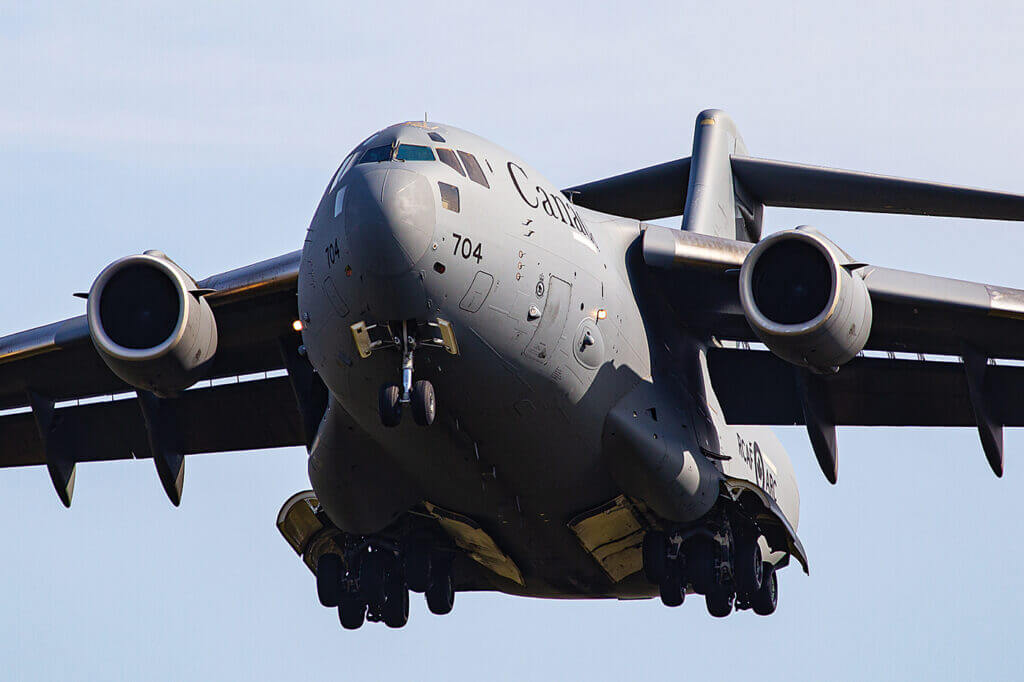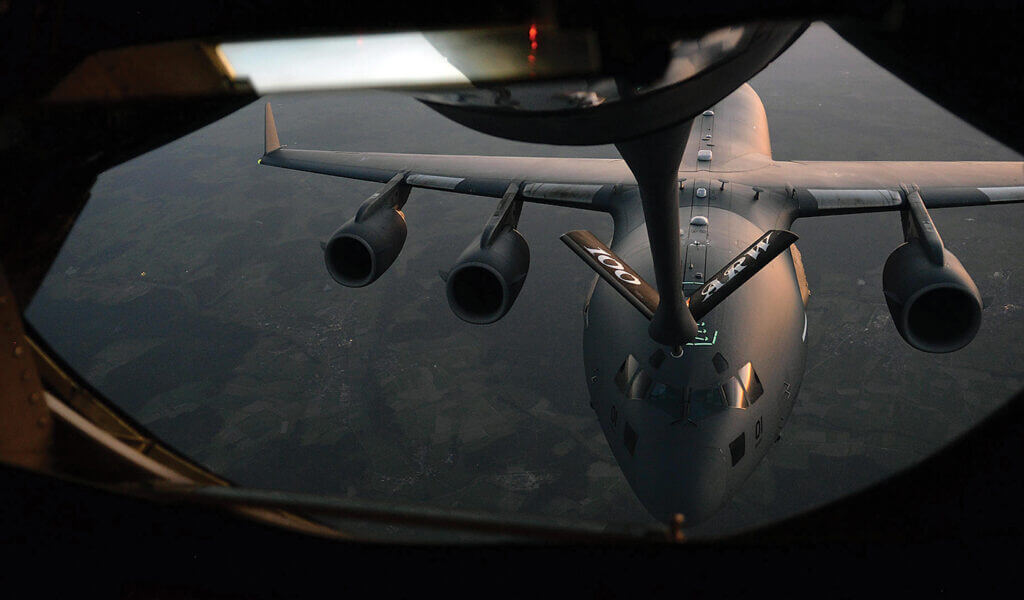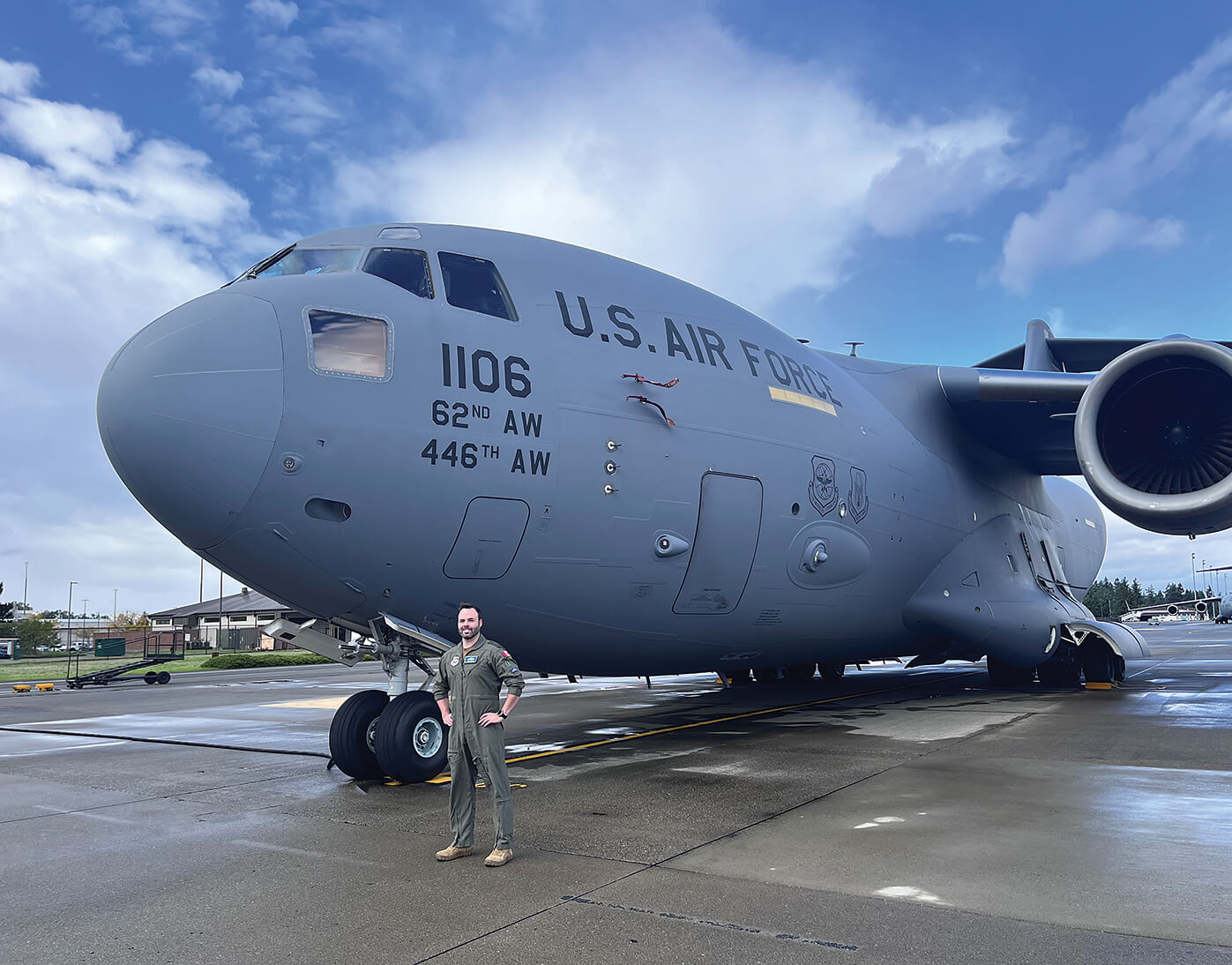Estimated reading time 11 minutes, 1 seconds.
As he guided the hull of a massive U.S. Air Force (USAF) Boeing C-17 Globemaster III aircraft toward the fuel boom of a KC-135 Stratotanker, high above the clouds over Washington state last November, Royal Canadian Air Force (RCAF) Captain Jeremie Burney stifled his nerves.
Temperatures hovered around freezing on a typically overcast day in the Pacific Northwest, and the Globemaster approached cautiously to refuel in mid-air. Its capped opening atop the giant, ghost-grey fuselage was open like a whale’s yawning spiracle.
Burney recalls being tense, but keeping his composure.

“I was pretty nervous,” he said in an interview months later, from his home near Joint Base Lewis-McChord in western Washington, where the seasoned pilot from 429 Transport Squadron at 8 Wing Trenton, Ontario, is serving a three-year pilot exchange with the USAF.
“Luckily, there’s always a qualified instructor in the seat beside you, who’s very closely monitoring your movements. But there is some hesitation to get very close, because you’re literally touching another aircraft through the boom, in flight.
“I was hesitant,” he said. “My first attempt was not as good as what I’ve been able to accomplish now.”
Burney had more than 1,000 hours on Canada’s similarly configured CC-177 Globemaster III before starting his USAF exchange in mid-2022, but had never participated in an air-to-air refuelling exercise to that point. Within a few months, it was a routine part of his skillset.
“It’s always rewarding to learn a new skill on an aircraft that you know,” he said. “And really, it’s just another capability of the C-17. It’s been very rewarding to be able to learn that skill set and get more proficient at it.”
Sharing expertise
Canada and the U.S. have operated an Air Force pilot exchange program for many years, giving members on both sides of the border chances to learn new skills and share their expertise while soaking up a new culture on and off the air base.
“It’s really about promoting understanding and interoperability between the USAF and RCAF,” said Burney, 34, who joined the RCAF in 2007 and has 10 years of military flying experience.
“We’re able to exchange information a bit easier, because now we have those professional and personal relationships between members of different air forces. It really pulls the two countries closer together.”
Lining up a pilot exchange placement requires extensive flying experience, good timing and a bit of luck. The RCAF only sends fully qualified Globemaster pilots south of the border, and placements only appear every three years.

When Burney joined 429 Squadron, he immediately developed a keen interest in the program. Thanks to hard work and good fortune, his career progression matched with the program’s availability timeline.
“I was offered the chance to go, and I didn’t hesitate for a second,” he said. Burney and his wife Jenna relocated to Washington with their four young children last year and settled into the rhythms of life in the USAF.
“We have always liked the idea of being able to go abroad, and just experiencing a different country, a different culture,” he said. “There’s just that sense of adventure, of going and doing something different with another air force, that really appealed to me.”
Apart from learning and translating new military acronyms, and a bit of good-natured ribbing about his Canadian accent, the transition has been smooth. There are only minor differences between the Canadian and American versions of the C-17; the main one is the lack of extended-range tanks on some of the USAF aircraft.
“That doesn’t really affect how it flies at the end of the day,” said Burney. “They’re very similar. We use the same set of technical orders published by Boeing.”
The USAF also uses its C-17s for low-level flying, a capability the RCAF typically doesn’t implement. Burney quickly got up to speed, despite the steep learning curve. He spent hours practicing the manoeuvres in a simulator, then went to the USAF’s C-17 schoolhouse at Altus Air Force Base in Oklahoma for a pilot check-out course.
“There was a lot to learn, initially,” he said. “And then a lot of it is just hands-and-feet flying. So, trying to get those reps in. The first time you ever get that close to another aircraft in the air at 20,000 feet is pretty daunting, but eventually, through repetition, you get more comfortable and it’s not quite as scary.”
Pilot duties
As a fully qualified pilot, Burney is required to be ready to fly training missions with the USAF and to move large quantities of cargo overseas. The C-17 has enough carrying capacity for tanks and military helicopters, and frequently transports supplies to remote locations overseas.

In the summer of 2023, Burney piloted a mission to Pituffik Space Base in Greenland, formerly known as Thule Air Base, the Pentagon’s northernmost station. Pituffik is the traditional Inuit name for the settlement that previously occupied the land where the base is located.
“It’s always rewarding to see the impact you made,” he said, recalling the sight of seeing base members picking up supplies off store shelves after the delivery. “I’m looking forward to many more experiences here.
“One of the most rewarding things is being able to rep, not just the RCAF, but Canada, to the squadron and the wing here,” he added. “You do stand out a little bit, having that Canadian flag on your shoulder.”
In the first 12 months of his exchange, Burney flew additional missions to Australia, Peru, Kuwait and Germany, plus several domestic flights. As a member of one of three active squadrons from USAF 62nd Operations Group stationed at McChord, he continues to log hours in the simulator and guides newer pilots and loadmasters through training plans designed to help them climb the ranks.
“We’re always working to get people upgraded to the next level, whether that be a brand-new pilot or loadmaster — we have to get them ready,” he said. “You’re always making sure that people are progressing and that we’re able to provide that support to the members.”
These duties are built upon a foundation of mutual respect between Canadian and American colleagues. Both Air Forces recognize the value in sharing knowledge and stretching outside their comfort zones to learn new skills.
“They bring a ton of experience up to Canada for us, and we do some things differently,” said Burney. “We fly a lot of cold weather, Far North operations, which they don’t fly as much [in the U.S.]. We bring that expertise with us when we come on the exchange, and it’s always been very respectful. There is a lot of mutual respect between the two countries.”
Flying the Globemaster
As a kid growing up in Turner Valley, Alberta, a town of about 2,000 people on the outskirts of Calgary, Burney dreamed of becoming a fighter pilot.
Like many future aviators, movies like Top Gun inspired him, as did CF-18 Hornet fly-bys and Canadian Forces Snowbirds demonstrations at the airshows he attended. He joined the Royal Canadian Air Cadets at age 12 as a member of 187 Foothills Squadron, and acquired glider pilot and private pilot licenses before studying aeronautical engineering at Royal Military College in Kingston, Ontario.

Back then, he wouldn’t have predicted a career built around the C-17. Now, as one of Canada’s most accomplished young pilots on that platform, he’s grown comfortable with the role.
“Things don’t always go as planned,” he said. “My initial goal wasn’t to become a multi-engine air mobility pilot, but I’m very happy with where my career has taken me to this point.”
The exchange program has stretched him, providing skills that will likely benefit him long into the future. After one year of a three-year placement, he’s eager and excited to tackle new challenges ahead.
“There’s just so much experience and knowledge in the USAF about the C-17,” he said. “Talking with instructors and evaluators here, and going into the simulator — there’s many different techniques to do the same manoeuvre. Always learning a different way to do something, I find rewarding.”
His next step is to qualify as a C-17 instructor pilot, and eventually bring that skill back to Canada to mentor the next wave of Canadian military aviators.
“I always enjoy learning, so I’m trying to soak up as much as I can while I’m here,” he said. “And just the relationship between the two air forces, continuing that, I’m very proud to be part of that lineage.”
Moving thousands of kilometres to Washington from his previous home in eastern Ontario wasn’t easy, particularly with four kids between the ages of two and eight. And Burney is quick to acknowledge the idea of an exchange can seem intimidating at first.
“But I think it’s a very rewarding experience,” he said. “When I joined the Air Force, I never thought I would be flying with the USAF and flying C-17s, but it’s been a great experience. I’m glad I took the chance to do it. It’s been great to represent Canada down here.”


Fantastic story! Thank you for your service Jeremie, and keep doing Canada proud!
So incredibly proud of you Jeremie! Keep flying strong!
The best part about mcChord is that if you get homesick Vancouver is just 2 hrs up the highway